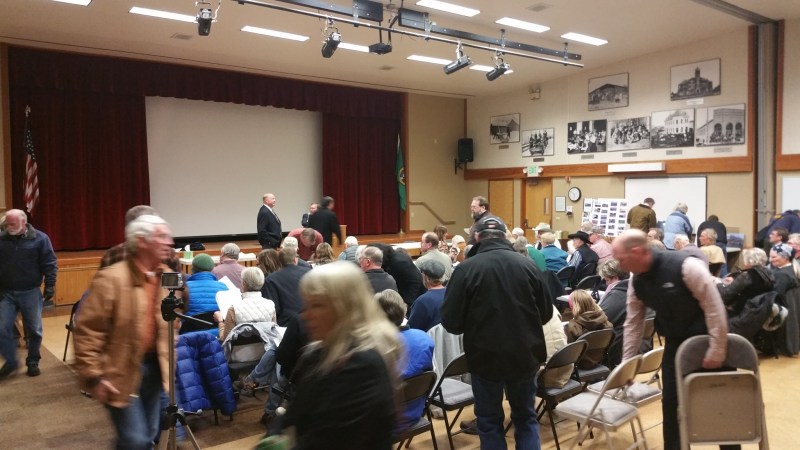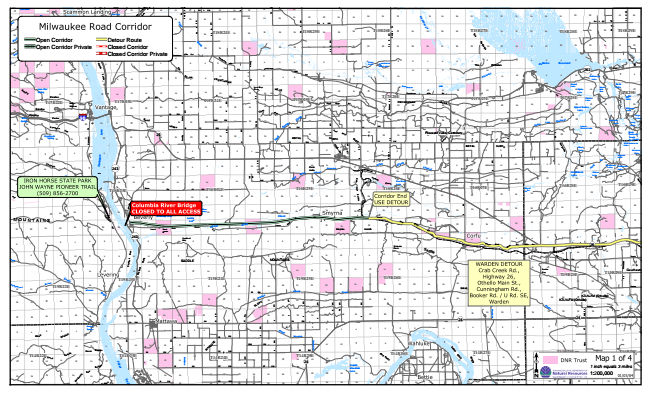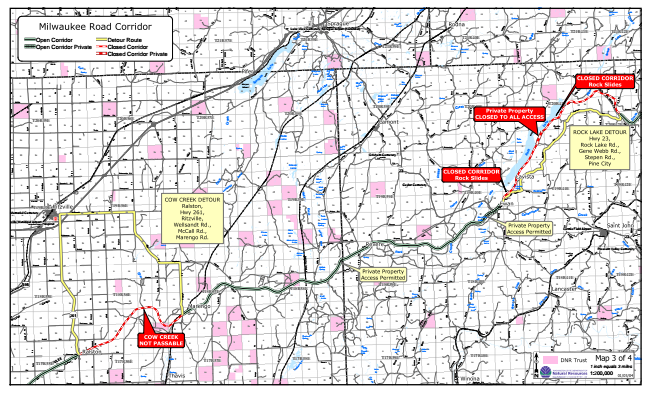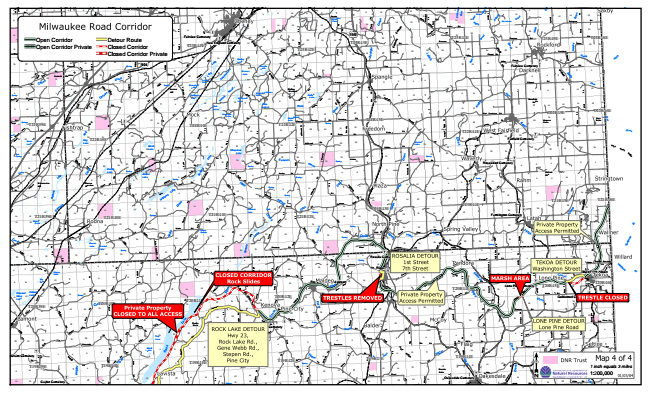By now most of you who are familiar with the trail are aware that there are some politics behind an attempt to close the trail by giving away 135 miles of the eastern section at no cost to the adjacent landowners. Representative Joe Schmick and Representative Mary Dye (while it sounds like Mary had very little involvement in this bill) inserted a last minute provision into the state’s capital budget without any public announcement or input. When questioned about it, he stated that he did not want to waste the time of his fellow legislators in such a trivial matter. Seriously? When was the last time we’ve ever heard of 6,000 acres of PUBLIC land being given away to landowners for free in near secrecy?
The ONLY thing that stopped this from squeaking by at the time was a typo in the bill that read “Columbia River to Columbia River” instead of “Columbia River to Malden”. Yikes. What an interesting thing to have happened. It’s such an odd error and we’re thankful that it happened. The stretch from Beverly at the Columbia to Malden is easily my favorite from the trip. Probably in part that I live on the west side and I’m surrounded by the mountains,trees and green. This eastern section is really none of that. For those reasons it sure brings out the adventurous side in you when you travel that stretch. It is full of geology. It’s a fantastic way to see a part of the state you’d never see from a car doing that very (imo) boring ride to Spokane once you hit the river. It’s an opportunity to safely travel by horse, foot, bicycle into an area that has spotty to no cell reception, away from the rest of the world.
Public Meeting – Ellensburg
Needless to say this issue with closing the trail has brought together a lot of folks who are in support of the trail who otherwise wouldn’t have had much interaction together. Ted Blaszak, Tekoa city council member and leader of the Tekoa Trail & Trestle Association was one of the first to start raising awareness of what was going on behind closed doors. I paraphrase some of Ted’s comments in this post. Ted and Rep. Schmick created a committee that would kick off the first public meeting about this in Tekoa, which was pretty wild west and heated I hear. From there they agreed on three more public meetings. One in Rosalia, one in Lind and the final one in Ellensburg. I was fortunate enough to be able to attend the Ellensburg meeting with my wife and friend Randy (who was on the trip with me) and some others we know that were there.
Over 200 people attended and it had 37 speakers. I learned quite a bit about about the power of the public’s voice and this process. The concerns of the local landowners seem to be very small issues if you ask me in the grand scheme of things. Key points mentioned were problems with weed control, fencing, trash “dumping”, vandalism, illegal hunting and fire danger. Many of these concerns are easily remedied with even small funding and volunteer work or not preventable by simply closing the trail. It’s not being done now because no one knows it needs to be done. Getting in proper gating so you can’t drive directly onto the trail and weed control are all manageable. I struggle to see where vandalism and serious illegal activity is happening as a direct result of the trail being there to the point that it is affecting the livelihood or safety of the locals. The only trash I saw dumped was on private property in Malden….which was not directly off the trail…more of a personal junk yard of sorts. I can guarantee you these washers and driers and old fishing boat carcasses were not carried in by horse or bicycle….or hikers. I agree with others that some more regular activity on the trail will significantly reduce illegal behavior, self-policing in a way.
Many passionate people spoke at the meeting. Some of them who had attended the other two meetings as well. There was a broad range of types of speakers. From soft spoken and reasonable and interested in a solution benefiting everyone involved to a local resident of Pine city stating that they would prefer to be left alone. That’s one of the main reasons they live there, that and to run an agriculture business that provides food for our state and beyond. They don’t need more industry or visitors. It’s a factory. This I totally get. I rode through Pine City (which isn’t actually a town, has a population of maybe a dozen or less). I fully understand why people live in these towns and like their privacy. By the time you get to Pine City as a cyclist, you have about zero interest in hanging around though since there is nothing there. It’s literally listed as a ghost town. This person did not have a single positive word to say about cyclists.
Genuinely, I’m very curious what specific issues she has encountered with two wheelers?. I can’t think of a group of people, other than hikers who are extremely active in trail maintenance, advocacy and leave no trace ethics. Even horses leave huge ruts in the trail that makes the trail very hard to bicycle over, let alone walk your dog on. Theft? Unlikely…I nearly cut the handle off my tooth brush to save weight so I can guarantee you adding anything more to my kit was not an option lol. We spent money in every town we traveled through.
Only TWO very outspoken landowners spoke that I noticed. Two out of nearly two hundred. Something tells me there is something not completely true when it comes to the overall concerns that these landowners are facing. Why are only two speaking up? Because they stand to benefit the most from the free land that runs through their property, in some cases 6 miles splitting their land would be my humble guess. How many folks were contacting Schmick about all these huge issues that got him to draft legislation in the first place? Are these letters available for the public to read? It’s amazing how easily and quickly something like this could’ve snuck by but reversing it is a monumental task.
The folks who spoke in favor of the trail ALL offered suggestions for how they could help, what could be done and how to go about fixing the issues. I was very disappointed to see that neither of the two speakers against the trail offered up suggestions on HOW to fix the problems. All they offered were some of the issues as the trail passes their land and that closing the trail was the ONLY possible outcome. It was hard to not immediately write them off as participants in the blatant land grab. Sorry but that pissed me off.
Still reading? Interested in what you can do to help support this trail?
What YOU Can Do to Help Save the Trail
Check out the current Social Media outlets with ongoing discussion and share the pages:
- Tekoa Trail & Trestle Association on Facebook
- The official website for the cause
- Contact every state legislator you can here in WA and voice your concern about funding for the trail
- Washington State Parks and Recreation Commissioners and Director’s Office
Write them in your own words expressing the need to keep the trail public and need for better funding for maintenance and upgrades. Touch on what makes the trail unique to WA and stress the need for proper funding to alleviate the concerns of the landowners and trail enthusiasts as well). This info is all available by contacting the Tekoa Trail & Trestle Association here.
You can also contact your WA city government to pass a resolution in support of the trail similar to those of Tekoa,Spokane,Palouse, Colfax and as of 11/24/15, Cle Elum.
This trail is the longest rail to trail conversion in the country. It is also only one of two cross state trails in the country. With a little work, you can cross the entire state by bicycle starting at the coast and riding the Olympic Discovery Trail route, take a quick ferry boat ride across Puget Sound and cross through Seattle on the Burke Gilman Trail and connect to the Snoqualmie Valley Trail that drops you off to the start of the John Wayne. Continuing on past Tekoa and through western Idaho.
This is something we should all be proud of. It’s in our history books and park of our heritage. Fight to keep it open for future generations to enjoy.
Feel free to follow my journey on the entire trail starting with day 1 Here







